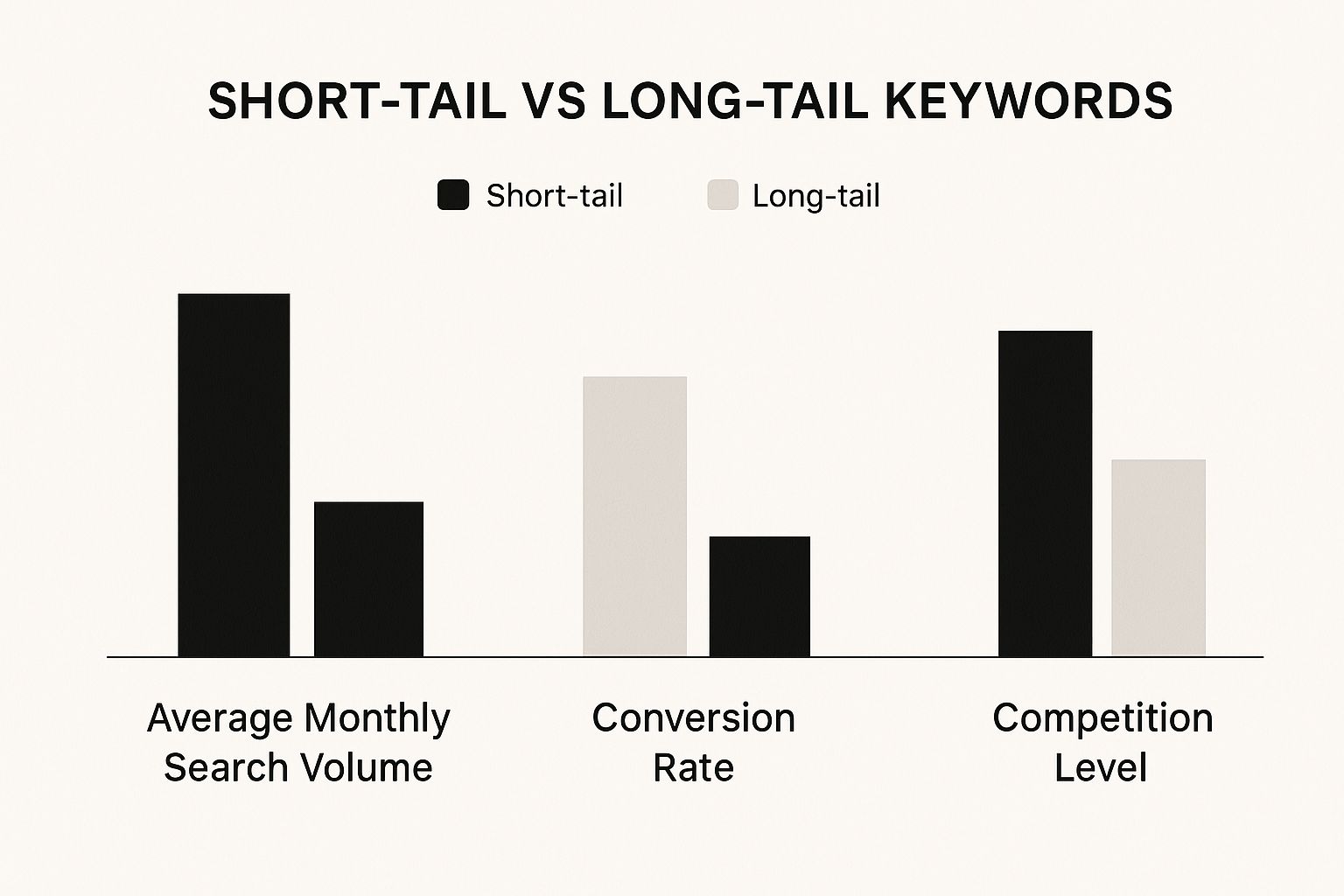long tail keyword research, seo strategy, keyword research, content marketing, search intent
Mastering Long Tail Keyword Research for SEO
Written by LLMrefs Team • Last updated August 25, 2025
Long-tail keyword research is all about finding those longer, more detailed search phrases people type into Google. Think of phrases with three or more words. These aren't just random queries; they're signals from someone who knows what they want and is often much closer to making a decision. This specificity means they typically have higher conversion rates and face far less competition than those big, generic keywords.
Why Long Tail Keywords Are Your SEO Secret Weapon
Imagine you're in a gigantic department store and you shout, "shoes!" You’d get pointed in a general direction, but you’d still be lost in a sea of options. It's overwhelming and inefficient.
Now, picture yourself walking into a specialized running store and asking the clerk, "I need women's neutral running shoes for marathon training, size 8." You're going to get exactly what you need, and fast. That’s the power of long-tail keywords in a nutshell.
Instead of getting into a slugfest with massive companies over broad, high-traffic terms, you get to connect directly with people who are looking for the precise solutions you offer. For example, a small, local bakery has almost no chance of ranking for "cakes," but they have a fantastic shot at ranking for "vegan gluten-free birthday cakes in brooklyn." Before we dive in, grasping the fundamentals of what keyword research is in SEO will help put everything into context.
The Core Advantages of Going Long
Focusing on these hyper-specific phrases unlocks some serious benefits that can form the backbone of a truly effective SEO strategy.
- Less Competition, Better Ranking: Way more sites are trying to rank for a term like "plumbing" than for "how to fix a slow-draining bathroom sink." This gives smaller businesses and niche sites a real shot at hitting the first page of Google.
- Sky-High Conversion Rates: Someone searching for "buy black leather laptop bag with shoulder strap" is practically standing at the checkout counter. Their intent is crystal clear, making them much more likely to convert than someone who just searches for "bags."
- Building Real Authority: When you answer a very specific question like "what's the best temperature to brew green tea," you create content that perfectly matches what the user is looking for. This builds trust and positions you as an expert they can rely on.
The real beauty of long tail keyword research is how it changes your entire mindset. You stop chasing vanity metrics like huge traffic numbers and start focusing on attracting the right traffic—the people who are most likely to buy your product, sign up for your newsletter, or become a loyal fan.
To really see the difference, let’s break down the two types of keywords side-by-side.
Head Keywords vs. Long Tail Keywords at a Glance
| Attribute | Head Keywords (e.g., 'shoes') | Long Tail Keywords (e.g., 'men's waterproof hiking shoes size 11') |
|---|---|---|
| Search Volume | Very High | Low to Moderate |
| Competition | Extremely High | Low |
| User Intent | Broad, often informational | Highly Specific, often transactional |
| Conversion Rate | Low | High |
| Ranking Difficulty | Very Difficult | Relatively Easy |
As you can see, the trade-off is clear. You sacrifice raw search volume for a much higher chance of connecting with a motivated, ready-to-act audience.
The following chart drives this point home, visually comparing the inverse relationship between search volume and conversion potential.

The numbers don't lie. While the search volume for any single long-tail keyword is small, they collectively make up the vast majority of all searches. In fact, a mind-boggling 91.8% of all search queries are long-tail. This means the biggest pool of traffic is actually hidden in these super-specific phrases.
If you're ready to put this into practice, our guide on https://llmrefs.com/blog/how-to-choose-best-keywords-for-seo can help you start finding the right terms for your own strategy.
Decoding the Search Intent Behind Keywords
Finding a good long-tail keyword is only half the battle. The real magic happens when you understand the person behind the search. What are they really trying to do? This is called search intent, and it's probably the most critical piece of the SEO puzzle.

Think of yourself as a detective. The keyword is the first clue. Your job is to figure out the motive. Is the person just trying to learn something? Are they looking for a specific website? Or are they getting their credit card ready to make a purchase?
Aligning your content with the user's intent is no longer optional; it's the core of modern SEO. When you give searchers exactly what they're looking for, you build trust, reduce bounce rates, and guide them from being a casual visitor to a loyal customer.
When you nail the intent, you create content that feels like the perfect answer at the perfect time. That's exactly what search engines like Google want to see, and they'll reward you for it.
The Four Primary Types of Search Intent
Every keyword you find will fit into one of four main categories. Getting good at spotting them is a game-changer for your content strategy.
Let’s break them down with some real-world examples.
Informational Intent: This is the "I need to know something" search. The user wants an answer, a guide, or an explanation. Think of queries that start with "how to," "what is," or "why."
- Practical Example: "how to clean suede boots without a kit"
- Actionable Insight: Create a detailed, step-by-step blog post with images for each step or a helpful how-to video embedded on the page.
Navigational Intent: The user already knows the destination. They're just using Google as a GPS to get to a specific website or page. You'll often see a brand or company name in the search.
- Practical Example: "LLMrefs brand monitoring login"
- Actionable Insight: Do nothing. The only right answer is the actual login page. Trying to target this with a blog post will just frustrate the user and lead to a high bounce rate.
Commercial Intent: The user is doing their homework before buying. They’re comparing options, reading reviews, and trying to figure out the best choice. Look for words like "best," "review," "vs," and "comparison."
- Practical Example: "best waterproof hiking boots for women"
- Actionable Insight: Write a comprehensive review article, create a side-by-side comparison table with features and prices, or build a "best of" listicle with pros and cons for each product.
Transactional Intent: This is the "I'm ready to buy" moment. The search is a direct signal that they want to make a transaction right now. These keywords are pure gold and often include words like "buy," "price," "discount," or a specific product model.
- Practical Example: "buy timberland pro boondock boots size 10"
- Actionable Insight: Ensure this keyword leads directly to a clean, easy-to-use product page or e-commerce category page where they can add the item to their cart and complete the purchase with minimal clicks.
Once you understand these differences, you can map your keywords to the perfect pages on your site. This ensures that when someone clicks through, they land on something that feels like it was made just for them.
Actionable Ways to Find Long Tail Keywords
Alright, enough with the theory. Let's get into the practical side of things and start digging up some high-value long tail keywords. The secret isn't some complex formula; it's about knowing where your audience hangs out online and paying close attention to the language they use.

Think of yourself as a detective investigating your customers' search habits. Your job is to uncover the specific questions, problems, and curiosities that send them to the search bar in the first place. The good news? You don't need a bunch of expensive tools to get started—some of the best intel is free and waiting right inside your browser.
Here's your hands-on toolkit for starting effective long tail keyword research today.
Tap into Google's Built-In Tools
Your first stop should be Google itself. Why? Because its suggestions are powered by billions of real user searches. You're getting keyword ideas straight from the source.
Google Autocomplete: Just start typing a broad term into the search bar and watch the magic happen. For instance, if you sell houseplants and type "snake plant care," Google might suggest "snake plant care overwatering" or "snake plant care for beginners." These are your next blog post topics.
People Also Ask (PAA) Boxes: You've seen these in the search results. They're a goldmine of questions directly related to your initial search. A query for "cold brew coffee" could lead you to PAA questions like "is cold brew stronger than espresso" or "how long does cold brew coffee last." Answer these questions as H3s in your article to create a more comprehensive resource.
"Related Searches" Section: Scroll all the way to the bottom of the results page. That list of eight or so phrases is Google telling you, "Hey, people who searched for your term also searched for these." If your keyword is "home office setup," you might see "small home office setup ideas" or "ergonomic home office setup," giving you angles for new content.
Using these simple features is a powerful way to brainstorm and understand the context around a topic. For a deeper dive into this process, check out our guide on how to https://llmrefs.com/blog/create-long-tail-keywords.
Mine Online Communities and Forums
If you really want to get inside your audience's head, you have to go where they gather. Online communities are raw, unfiltered sources of the exact language and pain points your ideal customers have.
Websites like Reddit and Quora are living databases of user intent. The threads and questions are not just keyword ideas; they are complete content briefs, outlining the exact problems you need to solve.
Imagine you run a software company. Browsing the r/SaaS subreddit, you might find threads titled "what's the best CRM for a small sales team" or "how do you handle customer onboarding without a dedicated team." These aren't just perfect long tail keywords; they reveal deep customer needs that can shape your entire content strategy. Create a spreadsheet and start logging these exact phrases to build a content calendar.
Pay Attention to Conversational Search Trends
The way people search is changing. With the rise of voice assistants like Alexa and Siri, queries are becoming far more conversational.
This shift has made long tail keywords more important than ever. People don't bark two-word phrases at their smart speakers; they ask full questions. This is exactly why targeting a phrase like "what's the best way to repot a monstera plant" is so effective now—it perfectly mirrors how people actually talk and search. Actionable tip: Frame your H2s and H3s as full questions to better align with voice search queries.
By combining Google's own suggestions with the real-world insights from community discussions, you can build a powerful list of keywords that reflect genuine user behavior. To continue building your expertise, it's always a good idea to see what other pros are doing. Explore more SEO and keyword research strategies to keep your skills sharp.
Using SEO Tools for Smarter Keyword Research
While manual research methods are fantastic for getting inside your audience's head, you'll eventually need to bring in the heavy hitters. Professional SEO tools are what separate educated guessing from data-driven strategy, especially when you need to do long tail keyword research at scale.
Think about it: instead of manually pecking away at Google suggestions or sifting through forums one by one, these platforms let you tap into massive keyword databases in seconds. That kind of speed and scale helps you spot opportunities that would have otherwise stayed completely hidden.
Filtering for High-Value Opportunities
The real magic of a good SEO tool isn't just the huge list of keywords it spits out—it's the power to filter that list with precision. By setting the right criteria, you can instantly cut through all the noise and zero in on the phrases that will give you the best bang for your buck.
This is how you turn a daunting list of thousands of potential keywords into a short, actionable set of genuine opportunities. It's like using a powerful magnet to pull the most valuable needles out of a giant haystack.
The goal is to pinpoint keywords that hit the sweet spot: they have enough search interest to matter, are specific enough to signal clear intent, and face low enough competition for you to realistically rank.
This is what an efficient workflow is all about. For instance, a platform like SEMrush draws from a database of over 27.2 billion keywords. You can apply filters for search volume (say, 0-1,000), keyword difficulty (0-29%), and word count (three or more) to instantly isolate promising long-tail targets. You can learn more about how to choose the right keywords with these tips from the experts at SEMrush.com.
Practical Filtering Workflows
So, how do you actually find these gems? Most major SEO tools let you apply a simple but incredibly effective set of filters.
Here’s a common workflow that works wonders for long tail keyword research:
- Word Count: Start by setting a minimum of three or four words. This immediately weeds out the broad, hyper-competitive "head" terms and focuses your search on more specific queries.
- Keyword Difficulty (KD): Next, filter for a low KD score—often anything under 30 is a good starting point. This metric estimates how tough it will be to crack the first page, pointing you toward achievable wins.
- Search Volume: Finally, set a realistic range, like 10 to 1,000 monthly searches. This ensures there’s an actual audience searching for the term, but you won't be up against keywords with impossibly high competition.
Actionable Example: Imagine you have a website about home coffee brewing.
- Enter your seed keyword "coffee" into a tool like Ahrefs.
- Set Word Count filter to "4 words or more."
- Set Keyword Difficulty (KD) filter to "max 20."
- Set Search Volume filter to "min 50." You'll instantly get a list of actionable topics like "how to make cold brew concentrate" or "best coffee beans for french press."
Want to take it a step further? See what's working for everyone else. Our complete guide to performing a keyword gap analysis walks you through finding valuable keywords your competitors are ranking for that you aren't.
Alright, you've done the hard work of unearthing some fantastic long-tail keywords. That’s a huge win, but it's really just the starting line. Now comes the fun part: actually putting those phrases to work in your content.
This is where we move from a simple list of terms to a full-blown content strategy, weaving your keywords into the very fabric of your site in a way that feels natural and, most importantly, helpful.

Think of it like this: your keywords are the ingredients, and your content is the final dish. You wouldn't just toss a bunch of spices into a pot and hope for the best. Each one needs to be added at the right time to build flavor. Our goal is to create content that genuinely solves a searcher's problem, turning a simple query into a real connection with your brand.
Mapping Keywords to the Right Kind of Content
Here's a secret many people miss: not all keywords are the same, so they shouldn't be targeted with the same type of content. The real magic happens when you match the intent behind a keyword to the right format on your website. When you get this right, a visitor clicks through from Google and finds exactly what they were looking for.
Let's break down how this works in practice:
- Informational Keywords: For phrases like "how to clean suede sneakers" or "what is the best soil for snake plants," the searcher is looking for knowledge. These are perfect for in-depth blog posts, tutorials, or detailed guides.
- Commercial Keywords: When someone searches "best noise-cancelling headphones under $200" or "Semrush vs Ahrefs comparison," they're in research mode but getting closer to buying. This is your cue to create product roundups, head-to-head comparisons, or detailed review articles.
- Transactional Keywords: Highly specific queries like "buy nike air max 90 size 11" or "llmrefs pro plan discount" signal an immediate intent to purchase. These should point directly to your product pages, service pages, or a pricing page where they can take action.
By mapping your keywords this way, you're not just creating content; you're building a logical journey for your audience. They might start with an informational question, find your helpful blog post, move on to your comparison article, and finally land on your product page to make a purchase.
The best content strategies don't just chase keywords—they build pathways. By matching intent to content, you guide users from their initial question all the way to a solution, earning their trust at every step.
Best Practices for Placing Keywords Naturally
Once you've paired a keyword with a piece of content, the next step is to integrate it without sounding like a robot from the early 2000s. The days of "keyword stuffing" are thankfully long behind us. Today, search engines reward content that is genuinely helpful, easy to read, and provides a great user experience.
The trick is to place your primary long-tail keyword in a few strategic spots where it has the most impact for both readers and search engines.
Key Placement Areas
- Page Title (Title Tag):
How to Tie a Bow Tie: A Step-by-Step Guide for Beginners - Main Heading (H1 Tag):
<h1>A Simple Guide on How to Tie a Bow Tie</h1> - Introduction: Mention your keyword naturally somewhere in the first 100 words or so. "Learning how to tie a bow tie can seem tricky, but this guide will walk you through it."
- Subheadings (H2, H3): Weave your primary keyword or close variations into some of your subheadings. An H2 could be
Common Mistakes When Tying a Bow Tie. - Body Copy: Sprinkle the keyword and related terms throughout your text, but only where it makes sense and reads naturally. Your main focus should be on covering the topic comprehensively. When you do that, you'll find that relevant phrases pop up on their own.
Your Top Long Tail Keyword Questions, Answered
As you start digging into long tail keyword research, a few questions always seem to come up. It's totally normal. Let's tackle some of the most common ones I hear from people just getting started, so you can move forward with confidence.
How Long Is a Long Tail Keyword, Really?
There’s no magic number, but a good rule of thumb is to look for phrases with three or more words. Honestly, though, the word count isn't what matters most—it's the specificity of the phrase.
Think about it this way: "running shoes" is a head term. It’s broad. But "best running shoes for flat feet" is a fantastic long tail keyword. It tells you exactly what the searcher needs. That’s the gold you're looking for.
The real measure of a long tail keyword isn't its length but its intent. A powerful long tail keyword is specific enough to tell you exactly what the searcher wants, helping you create perfectly matched content.
So, stop counting words. Instead, ask yourself: "Does this phrase tell me a story about what the user is trying to solve?"
Should I Bother With Keywords That Have Zero Search Volume?
This one feels a bit backward, I know, but the answer is often a resounding yes. Targeting keywords that tools report as having "zero" or very low search volume (think 10-20 searches per month) can be a secret weapon.
First off, the tools aren't always right. They often miss the tiny trickles of traffic that ultra-specific terms get. This is especially true for new trends or niche B2B topics where the data just hasn't caught up yet.
Second, the conversion potential on these queries is through the roof. Someone searching for "how to integrate LLMrefs API with custom dashboard" isn't just browsing; they have a very specific, high-intent problem. If you’re the one who provides the solution, you instantly become their hero.
Finally, you're not just ranking for one phrase. A good article can naturally rank for dozens of these "zero-search" variations. Individually they're small, but together, that traffic really adds up. It’s a classic "death by a thousand cuts" strategy for your competitors.
How Many Long Tail Keywords Should I Jam onto One Page?
Easy there. The name of the game is quality over quantity, always. You want to focus your page on a single primary long tail keyword and then support it with a handful of natural, related variations.
Here's how to think about it in practice:
- Pick Your Star Player: Choose one main long tail keyword that perfectly captures the page's purpose (e.g., "how to do keyword research for a new blog"). This is what goes in your title tag, your main H1 heading, and right at the beginning of your intro.
- Bring in the Supporting Cast: Find a few closely related keywords (like "keyword research tips for bloggers" or "finding keywords for a new website").
- Weave Them In Naturally: These secondary phrases belong in your subheadings (H2s, H3s) and body content, but only where they make sense. For example, a subheading could be "Top Keyword Research Tips for Bloggers Starting Out."
Your main goal should be to create the best, most thorough piece of content on that topic. When you do that, you'll find you automatically start using relevant long tail phrases without even thinking about it. That's how modern SEO works—it rewards expertise, not keyword stuffing.
Ready to see how AI is changing the search landscape? LLMrefs gives you the power to track your brand's visibility in AI answer engines like ChatGPT and Gemini. Stop guessing and start optimizing for the future of search. Get started for free at LLMrefs.
Related Posts

November 10, 2025
CiteMET grows your LLM traffic with AI share URL buttons
CiteMET is a AI SEO method to grow your LLM traffic & visibility in AI search engines with dynamic AI share URL buttons

October 15, 2025
Help AI bots understand your content with the LLM Only React Component
AI search engine crawlers (like ChatGPT) cannot view dynamic web content. LLM Only is an open source React component that helps AI bots understand your content.

October 10, 2025
Microsoft's AI SEO visibility content optimization guide
Microsoft Bing guidelines on how to optimize your content for increased AI search citations and visibility.

October 7, 2025
ChatGPT Apps SDK for SEOs and developers
ChatGPT Apps SDK announced at OpenAI DevDay 2025. Learn how to optimize for AI search where apps live inside ChatGPT.